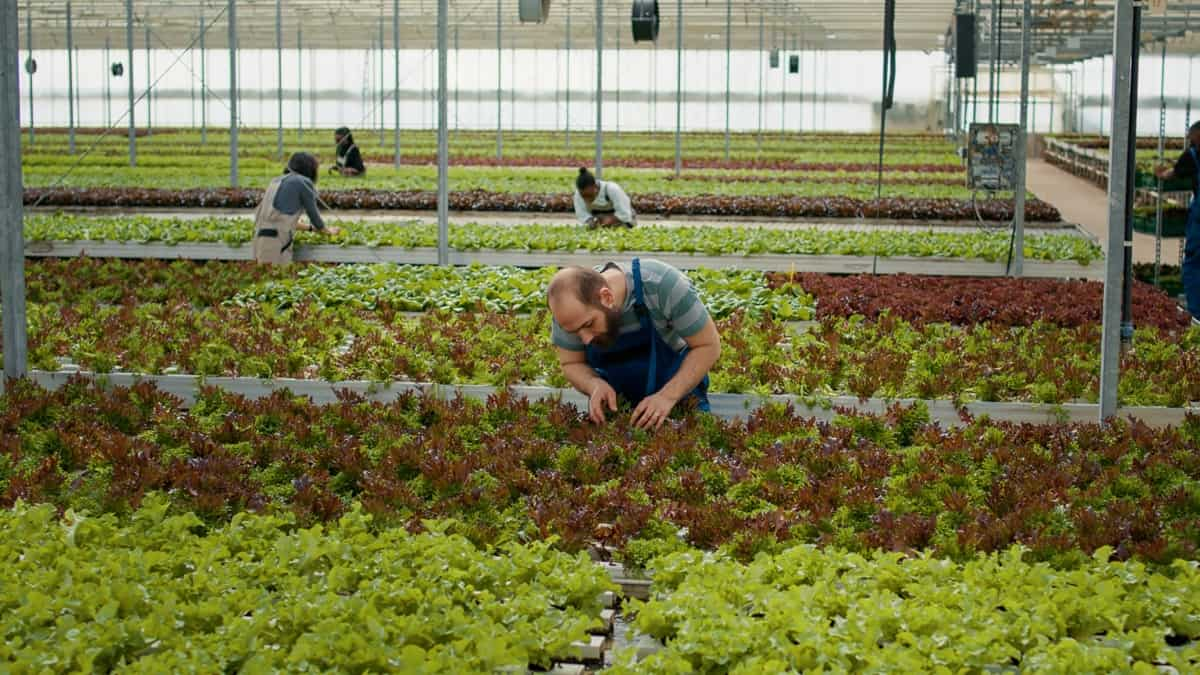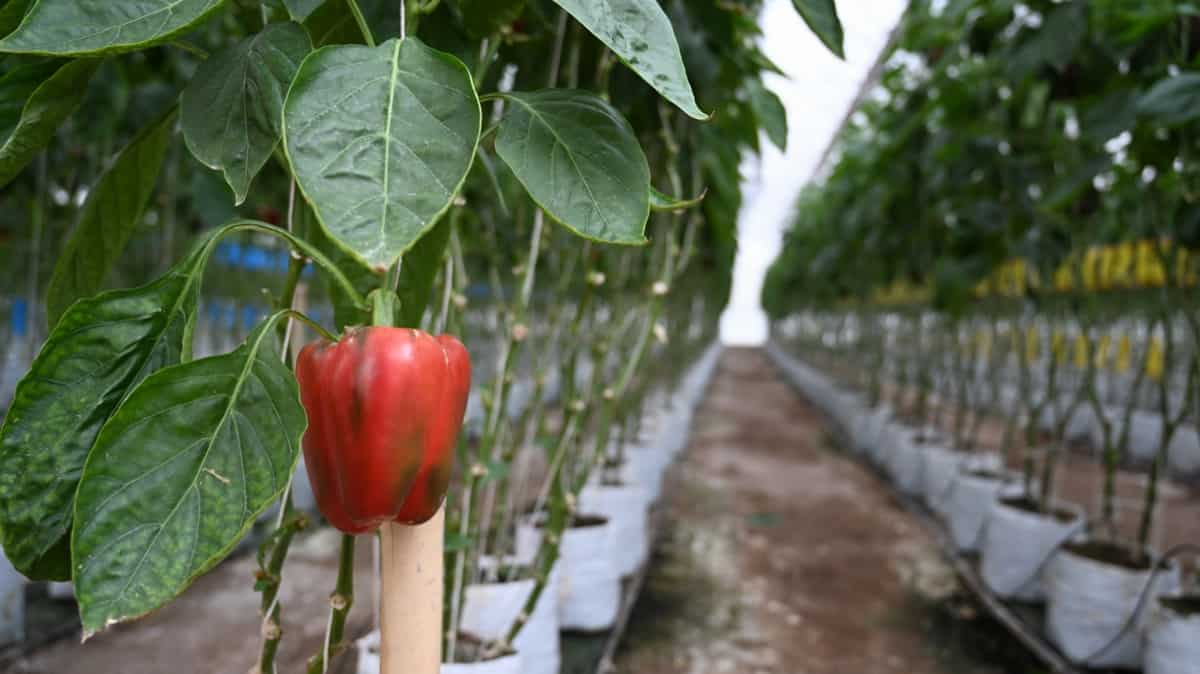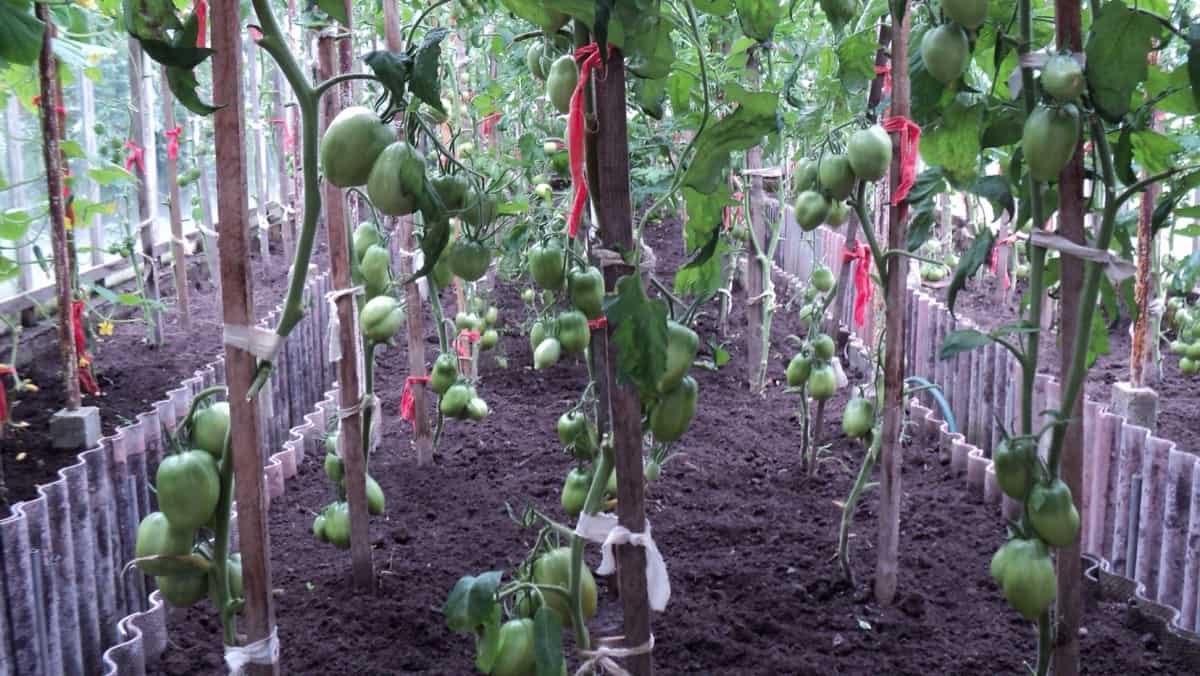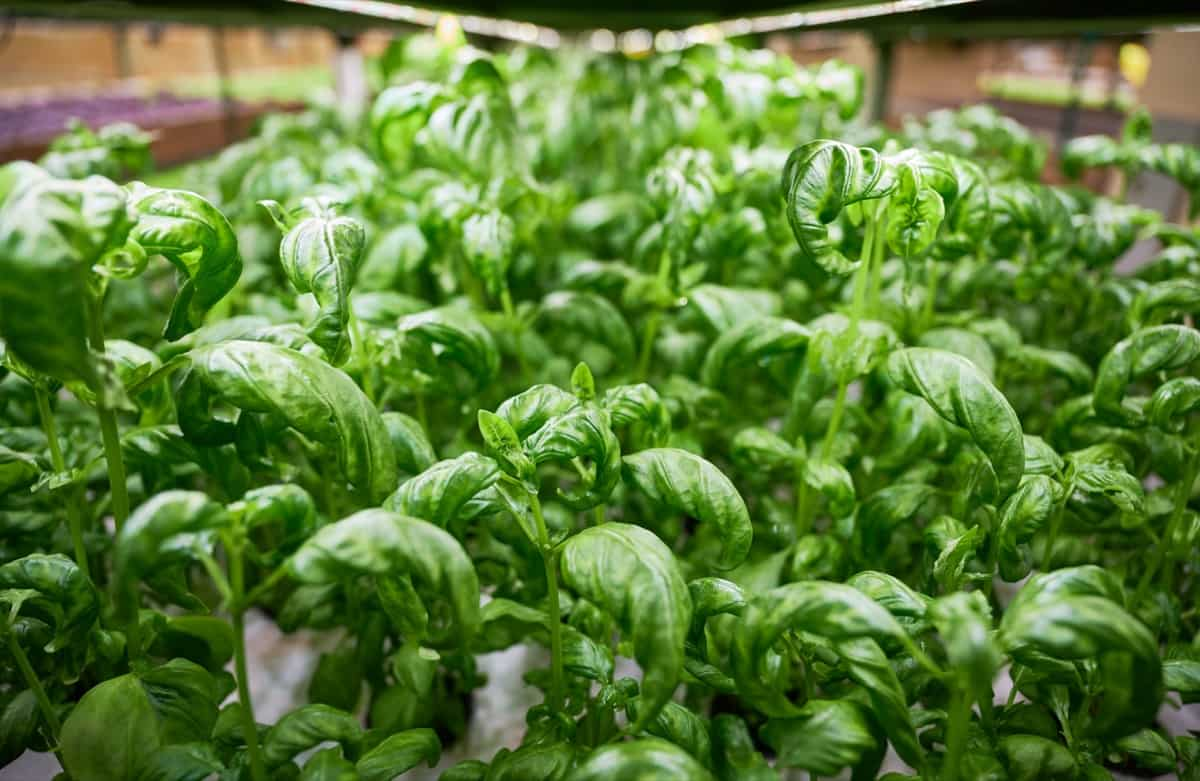Greenhouse farming is a popular agricultural technique that allows growers to extend the growing season by using artificial lighting and heating. This type of farming is becoming increasingly popular and more populated and food production. Many private companies have established greenhouses to cultivate various vegetables and fruits.

How to Start Greenhouse Farming in Rajasthan
What is Greenhouse Farming?
Greenhouse farming is growing crops in artificially heated and ventilated enclosures. The temperature inside a greenhouse can be controlled within a narrow range, which allows for the cultivation of a wide variety of plants. Greenhouse farming is becoming increasingly popular in Rajasthan due to its high rainfall and humidity levels, making it ideal for cultivating vegetable and fruit crops.
The scope of greenhouse farming in Rajasthan is wide, and crops like vegetables, fruits, flowers, and ornamentals can be cultivated in a greenhouse. In Rajasthan, many government-owned agricultural land areas have been set up to cultivate greenhouse crops such as tomatoes, cucumbers, eggplant, etc.
How Does Greenhouse Farming Work?
In greenhouse farming, crops are grown in large enclosed areas called greenhouses. The greenhouses are usually made of plastic and glass and can hold many plants. The heat from the sun is directed onto the plants through windows on all sides of the greenhouse.
This heating process makes it possible to grow crops year-round in many parts of the world that would otherwise be too cold or too hot for agriculture. The greenhouse effect can create an artificially heated environment for plants. This allows farmers to grow crops year-round in temperate and tropical climates.
In case you missed it: Goat Farming in Rajasthan: Step-By-Step Guide, Business Plan, Breeds, Setup Cost, Profit, and Requirements

Greenhouse Vegetable Production in Rajasthan
The main advantages of greenhouse farming are its efficient use of land, its conservation of energy, and its production of high-quality food year-round, regardless of weather conditions. Some crops you can grow in Rajasthan using a greenhouse:
| Cucumbers | Snow peas |
| Tomatoes | Lettuce |
| Peppers | Basil |
| Zucchini | Oregano |
| Cilantro |
Crops are Grown Under Greenhouses in Rajasthan
Greenhouse farming is most commonly used to grow vegetables, fruits, flowers, and grains. Crops grown in a greenhouse successfully include Tomatoes, Peppers, Strawberries, Lettuce, Cucumbers, Melons, Beans, Avocados, Eggplants, Potatoes, Cauliflower, Cabbage, Spinach, Peas, and Corn.
Crops grown in greenhouses typically require less water than those raised outdoors, making them suitable for areas with scarce resources. Additionally, subsidies and loans are available to encourage greenhouse farming in Rajasthan. Greenhouse farming in Rajasthan is a growing industry; many crops can be grown using a greenhouse.
Crops grown in greenhouses typically require less care than those grown outdoors. The greenhouse environment is controlled carefully, so the plants receive the right amount of humidity and sunlight. This makes greenhouse farming an ideal option for crops that require special care, like tomatoes.
Several types of crops can be grown using greenhouse techniques in Rajasthan, including fruit trees (e.g., Apples, Pears), vegetables (e.g., Tomatoes, Cucumbers), flowers (e.g., Lilies), and citrus fruits (e.g., Oranges). Grapes, Mangoes, Apples, Pears, and Apricots are fruits grown in a greenhouse. Flowers that can be grown in a greenhouse include Orchids and Roses.
Is Greenhouse Farming Profitable in Rajasthan?
It is becoming increasingly popular in India to increase crop yields and reduce dependence on monsoon rainfall. Rajasthan is a good place to start greenhouse farming because of its ample sunlight and warm weather. It is profitable in Rajasthan, provided the crop market prices and adequate access to credit are high enough. It is a type of agriculture where crops are grown in artificial shelters.
In case you missed it: Growing Vegetables and Fish Together in the Backyard: Starting a Backyard Aquaponics

Greenhouses can be used to cultivate a wide variety of plants and vegetables, including fruits and flowers. Crops grown in greenhouses can be sold at a higher price than those grown outside because the greenhouse effect increases their temperature and humidity levels, giving them a longer shelf life. Greenhouse farming has recently become popular in Rajasthan because of its hot, dry climate and high sunlight exposure.
Can You Grow in a Greenhouse Farming Year-Round in Rajasthan?
Greenhouse gardening in Rajasthan can be done year-round, though summer is the best time to grow produce as the weather is hotter and there is less humidity. To get started, people need to know the cost of acreage and greenhouse construction in Rajasthan. Several subsidies and loans are available to help with greenhouse farming in Rajasthan.
Cost to Build a Greenhouse in Rajasthan
The cost of an acre of greenhouse in Rajasthan ranges from Rs. 60,000 to Rs. 1 lakh. The state government provides up to 50% subsidy on the cost of an acre of the greenhouse. Loans can also be obtained to help finance the purchase of an acre of the greenhouse. This price includes the purchase of the land, building materials (such as glass and metal sheets), installation of the greenhouse structure, and initial equipment costs.
Number of Greenhouses in Rajasthan
There are a total of 1,236 greenhouses in Rajasthan. Greenhouses have increased by 25% in the past two years. This is mainly due to increased agricultural exports and rising demand for vegetables and fruits.
Key Rules to Start Greenhouse Farming in Rajasthan
- To set up a greenhouse business in Rajasthan, you’ll need to research the acreage cost and build an estimate of your total project costs. You can find this information on government or agricultural websites or by contacting local farmers.
- Once you estimate your total project costs, you’ll need to determine if you qualify for any subsidies or loans. The Rajasthan government offers several incentives for businesses involved in agriculture, including greenhouses. However, these programs are subject to change at any time, so it’s important to check with the appropriate office beforehand.
- It’s time to create a business plan once you’ve determined your project costs and eligibility for subsidies and loans. This will outline your goals for the greenhouse, how you plan to attract customers and generate revenue, and how you will ensure that the greenhouse remains operational throughout its lifespan.
- In Rajasthan, greenhouses can be a great way to start small-scale greenhouse farming. Choose the right crops for your greenhouse. Try to specialize in particular types of crops, as this will make the process more manageable and allow you to control the quality and production of your products.
In case you missed it: Greenhouse Farming in Karnataka: Crops, 1 Acre Greenhouse Cost, Subsidy, and Loans

- Get a subsidy or loan from your local government or agricultural society. This will help cover the cost of greenhouse farming in Rajasthan.
- Plan your cultivation carefully. Make sure you properly plan out how much space you will need, what type of climate you will be growing plants in, and how often you will need to water/fertilize them.
- A greenhouse comprises several parts, including the roof, walls, floor, and windows. The type of greenhouse you choose affects your crop’s growth and production. For instance, a cold frame has thicker walls and less air space between them than a heated glasshouse, allowing more sunlight to penetrate.
- If you want plants to grow tall and thick leaves, you need plenty of light. But too much light can also damage them, so make sure to position your greenhouse so that it gets the right amount of sun exposure but doesn’t get too hot inside.
Steps to Create Greenhouse Framing Business Plan in Rajasthan
1. To begin a greenhouse farming business in Rajasthan, you must identify the types of crops you would like to grow. Many different types of crops can be grown in a greenhouse, including cash crops such as fruits and vegetables, crops used for pharmaceuticals or medical products, and ornamental plants.
2. Once you have identified the types of crops you would like to grow, you will need to estimate the amount of space required to grow them. The size of the greenhouse will depend on the crop type you are growing and the climate conditions in Rajasthan.
3. The first step is to organize yourself and figure out what you need to start your greenhouse farming business. This includes developing goals and objectives, creating a budget, and identifying key resources (such as land, labor, and equipment).
4. The next step is researching the industry before starting your greenhouse farming business. This will help you understand the competition and learn about the latest trends in the greenhouses industry.
In case you missed it: Greenhouse Farming in Maharashtra: Crops, 1 Acre Greenhouse Cost, Subsidy, and Loans

5. After creating a marketing plan and implementing targeted sales campaigns, developing a Sales Strategy will help you reach your target market. This may include setting up distribution channels and negotiating contracts with suppliers/customers.
6. Before starting your greenhouse farming business, it is important to research the market and determine what crops are most popular in your area. This type of agriculture you want to focus on enables you to set appropriate prices for your products.
7. Once you have determined financial parameters and the most popular crops in your area, choosing a location for your greenhouse farm is important. Ideally, the location should be close enough to major population centers so that customers can easily access your products and rural enough so that pests do not pose a significant threat.
8. The business must identify potential markets for its product and develop a marketing strategy to reach them. After developing a marketing strategy, the business must create a financial plan to support production. Finally, the business must determine how much capital it will need to start producing its product and make necessary investments.
Greenhouse Framing Subsidies in Rajasthan
To operate a greenhouse farm in Rajasthan, one must first obtain a license from the authorities. The cost of registering a greenhouse farm varies depending on the size of the farm. There are several government subsidies available for greenhouse farmers in Rajasthan. These include crop insurance schemes (such as Pradhan Mantri Fasal Bima Yojana), interest subvention schemes for small farmers, and animal feed subsidy schemes.
In addition, several private lending institutions offer loans at low-interest rates to aspiring greenkeepers. Greenhouse farming is becoming increasingly popular in Rajasthan, a state in the northwestern region. The state has a tropical climate and ample sunlight, which makes it ideal for farming vegetables and fruits.
The government of Rajasthan offers several subsidy programs designed to help small businesses grow their businesses. These programs include interest-free loans and tax breaks on inputs such as seeds and fertilizer. There are also grant programs available that can cover a portion of the costs related to starting a greenhouse farm.
In case you missed it: State Wise Tomato Farming Seasons in India: Growing Best Varieties and Production Yield

Are Loans Available for Greenhouse Farmers in Rajasthan?
Yes, loans are available for greenhouse farmers in Rajasthan. The interest rate for a loan for a commercial greenhouse is around 8%. However, the Rajasthan government provides a subsidy of Rs. 5,000 per acre for growing vegetables and fruits in greenhouses. You will need to factor in the cost of solar panels and water pumps needed to run the greenhouse.
Once your materials have been gathered and costs have been calculated, it is time to look into getting a loan or government subsidy. Loans may be available through banks or agricultural credit societies, while government subsidies may be available through district agriculture offices or state governments. It is important to contact these institutions early on so that proper paperwork is completed and approvals are obtained.
Challenges of Greenhouse Farming in Rajasthan
The main challenge with starting a greenhouse farm is ensuring sufficient sunlight enters the plant throughout the day. This can be achieved by installing an acre glasshouse that provides natural sunlight and protection from bad weather conditions. Another challenge farmers face the lack of irrigation facilities in most parts of Rajasthan. This makes it difficult for them to sustain crop production under glass without using too much water or expensive artificial irrigation systems, which may not be cost-effective in the long run.
To overcome these challenges, the government of Rajasthan has made efforts to promote greenhouse farming. For example, it provides subsidies for greenhouses construction and loans to cover the costs associated with establishing a greenhouse farm. The state has also developed policy guidelines for greenhouse farming that address issues such as crop selection and irrigation systems. These initiatives are helping to make greenhouse farming more accessible to small farmers in Rajasthan and hopefully will lead to increased adoption of this innovative agricultural technique.
In case you missed it:15 Potting Soil Mixes for Bonsai Plants: Best List

Conclusion
Greenhouse farming uses natural or artificial means to regulate temperature and humidity levels to produce crops. In Rajasthan, greenhouse farming is particularly popular due to the state’s high temperatures and humidity levels. Greenhouse farming has been rising recently, as it is a more sustainable option for farmers. It involves growing crops in a controlled environment, which helps to reduce the amount of water, energy, and land used.
- Goat Farming Technology: The Future of Goat Husbandry
- How to Build a Low-budget Goat Shed: Cheap Ideas and Tips
- Goat Farming Training Programs in India: A Beginner’s Guide
- Types of Pesticides Used in Agriculture: A Beginner’s Guide
- Economical Aquaculture: A Guide to Low-Budget Fish Farming
- 15 Common Planting Errors That Can Doom Your Fruit Trees
- How to Make Houseplants Bushy: Effective Tips and Ideas
- Innovative Strategies for Boosting Coconut Pollination and Yield
- Pollination Strategies for Maximum Pumpkin Yield
- The Complete Guide to Chicken Fattening: Strategies for Maximum Growth
- Natural Solutions for Tulip Problems: 100% Effective Remedies for Leaf and Bulb-Related Issues
- Revolutionizing Citrus Preservation: Towards a Healthier, Greener Future
- Natural Solutions for Peony Leaf and Flower Problems: 100% Effective Remedies
- Maximizing Profits with Avocado Contract Farming in India: A Comprehensive Guide
- Natural Solutions for Hydrangea Problems: 100% Effective Remedies for Leaf and Flowers
- The Ultimate Guide to Choosing the Perfect Foliage Friend: Bringing Life Indoors
- From Sunlight to Sustainability: 15 Ways to Use Solar Technology in Agriculture
- The Ultimate Guide to Dong Tao Chicken: Exploring from History to Raising
- The Eco-Friendly Makeover: How to Convert Your Unused Swimming Pool into a Fish Pond
- Mastering the Art of Delaware Chicken Farming: Essentials for Healthy Backyard Flocks
- 20 Best Homemade Fertilizers for Money Plant: DIY Recipes and Application Methods
- How to Craft a Comprehensive Free-Range Chicken Farming Business Plan
- Brighten Your Flock: Raising Easter Egger Chickens for Beauty and Bounty
- How to Optimize Your Poultry Egg Farm Business Plan with These Strategies
- Subsidy for Spirulina Cultivation: How Indian Government Schemes Encouraging Spirulina Farmers
- Ultimate Guide to Raising Dominique Chickens: Breeding, Feeding, Egg-Production, and Care
- Mastering the Art of Raising Jersey Giant Chickens: Care, Feeding, and More
- Ultimate Guide to Raising Legbar Chickens: Breeding, Farming Practices, Diet, Egg-Production
- How to Raise Welsummer Chickens: A Comprehensive Guide for Beginners
- How to Protect Indoor Plants in Winter: A Comprehensive Guide
- Ultimate Guide to Grow Bag Gardening: Tips, Tricks, and Planting Ideas for Urban Gardeners
- Guide to Lotus Cultivation: How to Propagate, Plant, Grow, Care, Cost, and Profit
- Agriculture Drone Subsidy Scheme: Government Kisan Subsidy, License, and How to Apply Online
- Ultimate Guide to Raising Araucana Chickens: Breed Profile, Farming Economics, Diet, and Care
- Bringing Hydroponics to Classroom: Importance, Benefits of Learning for School Students
- Ultimate Guide to Raising Polish Chickens: Breed Profile, Farming Economics, Diet, and Care